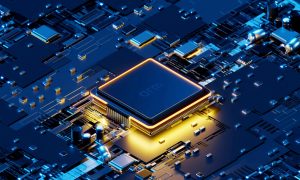

News Highlights:
- New Arm Total Solutions expand high-performance microcontroller and application use-cases with the latest Corstone subsystems for Cortex-M and Cortex-A
- Arm Cortex-M85 processor offers increased performance, improved machine learning capabilities and enhanced security
- Arm Virtual Hardware delivers a broader range of virtual development opportunities for Arm processors, third party hardware and real-world devices
Cambridge, UK, April 26, 2022 – Arm is delivering on its Total Solutions for IoT roadmap, with two new solutions for Arm® Cortex®-M and Cortex-A processors, streamlining and accelerating the IoT and embedded development process. As part of the expanded roadmap, Arm is launching the Arm Cortex-M85 processor, the highest-performing and most secure Cortex-M to date, and expanding Arm Virtual Hardware to more platforms, including 3rd party devices, to make the development process more accessible.
“Developers drive the future of the IoT, but they face an ever-increasing demand for higher performance, increased security and less complex development flows,” said Mohamed Awad, vice president of IoT and Embedded at Arm. “The IoT runs on Arm, and we have a responsibility to create greater opportunities for IoT innovation and scale by continually raising the bar on performance, simplified development, and software reuse for our ecosystem.”
Accelerating innovation with Arm Total Solutions for IoT
When Arm Total Solutions for IoT launched six months ago it signified a radical shift in the design approach for the IoT and embedded markets, combining hardware IP, platform software, machine learning (ML) models, tools and much more to simplify development and accelerate product design. At the heart of Total Solutions is Arm Corstone™, a pre-integrated, pre-verified IP subsystem that frees silicon designers to focus their time and efforts on differentiation.
Launching today, the Arm Total Solution for Cloud Native Edge Devices is the first designed for Cortex-A and based on Corstone-1000. It makes the power and potential of platform operating systems like Linux easily available to IoT developers, for the first time. It allows application-class workloads to be developed for devices such as smart wearables, gateways, and high-end smart cameras. Since the Corstone-1000 is Arm SystemReady™-IR compliant and features a hardware secure enclave that supports PSA Certified for a higher level of security, original equipment manufacturers (OEMs) can immediately enjoy the benefits of Project Cassini.
Arm’s new Total Solution for Voice Recognition is based on the Corstone-310 subsystem. It is pre-integrated with the new Cortex-M85 and the Arm Ethos™-U55 to create Arm’s highest ever performance MCU-based design. The solution is targeted at use-cases ranging from smart speakers and thermostats to drones and factory robots. Developers can also take the Corstone-310 and create a whole range of additional high-performance products by combining it with different reference software.
Arm Cortex-M85: Setting a new standard for secure, high-performance microcontrollers
The Arm Cortex-M85 is the highest performance Cortex-M processor to date and is a natural architectural upgrade path to Armv8-M for applications requiring significantly higher performance. It offers:
- A 30% scalar performance uplift compared to the Cortex-M7
- Arm Helium™ technology to support endpoint ML and DSP workloads
- Enhanced security with Arm TrustZone® technology. It also includes Pointer Authentication and Branch Target Identification (PACBTI), a new architectural feature with enhanced software attack threat mitigation to help achieve PSA Certified Level 2, a security baseline for IoT deployments
Arm Virtual Hardware now addresses existing devices, hardware and projects
Arm Virtual Hardware is a transformative offering, designed to enable software development in advance of silicon. It allows the Arm ecosystem to easily adopt cloud-based development and CI/CD, without the need for large custom hardware farms. Hundreds of developers have used Arm Virtual Hardware to date and based on developer feedback, Arm is announcing several new virtual devices to broaden Arm Virtual Hardware’s appeal. New additions will include Arm Virtual Hardware for the new Corstone designs as well as 7 Cortex-M processors ranging from Cortex-M0 to Cortex-M33. Arm is further expanding the library with third party hardware from partners including NXP® Semiconductors, ST Microelectronics and Raspberry Pi.
By extending Arm Virtual Hardware to ecosystem devices and the vast majority of the Cortex-M product line, independent software vendors and cloud service providers can now take advantage of the billions of Arm-based IoT and embedded devices which are already deployed.
Creating the foundation for standardized IoT development
In order to scale, the Cortex-M software ecosystem needs to coalesce around a consistent set of standards that enable the portability and re-use of software across a range of devices. Project Centauri was launched to deliver exactly that, so developers can focus on what really matters – innovation and differentiation. It includes Open-CMSIS-Pack, which is already supported by 9,500 microcontrollers and 450 boards, enabling software vendors to easily scale their offerings across all of these devices.
Today, Arm continues to invest in Project Centauri by delivering the first release of the Open IoT SDK Framework. This contains the new Open-CMSIS-CDI software standard, a community driven project hosted in Linaro that defines a Common Device Interface (CDI) for the Cortex-M ecosystem. Eight key industry players are already involved including silicon partners, cloud service providers, original design manufacturers (ODMs) and OEMs.
Empowering developers to serve a diverse and growing market
The IoT and embedded market is incredibly diverse and serves everything from sensors to robotics, smart speakers, appliances, storage controllers and computer vision. In a market this broad, streamlining development is critical, and today’s announcements reinforce why Arm is uniquely positioned to lead the IoT ecosystem forward, ignite growth and value creation across the IoT economy.
Notes
Arm Cortex-M85, Corstone-310 and Corstone-1000 are available for licensing now and can be accessed immediately as Arm Virtual Hardware in the cloud as part of Arm Total Solutions for IoT.
Arm Virtual Hardware can be accessed at https://avh.arm.com. Third party hardware is available from partners including NXP (iMX8 Arm Cortex Complex), ST Microelectronics (STM32U5 Discovery Kit) and Raspberry Pi (RPi4).
More information on Project Centauri can be found at arm.com/solutions/iot/project-centauri
Supporting Partner Quotes
Amazon Web Services
“FreeRTOS is the most popular RTOS for embedded development, supporting hundreds of different Arm devices. That breadth of support is a challenge to our need for efficient continuous testing, which today uses an operationally expensive board farm. Arm Virtual Hardware running in the AWS cloud provides a simpler, faster, and cost-effective way to scale our CI testing.” Richard Barry, Senior Principal Engineer at Amazon Web Services (AWS) IoT and FreeRTOS founder
Baidu
“As the IoT continues to evolve, the integration of open-source platforms for deep learning with SoC design platforms will hugely increase the efficiency of smart device development. With the deep integration of the PaddlePaddle (PP) industry-level model library and inference capability with Arm Virtual Hardware, developers can quickly and efficiently deploy the PP-series models, one of the most popular industry-grade models on GitHub, on Cortex-M based hardware, to quickly complete the prototype validation of endpoint AI systems.” Qiao Zhao, Head of PaddlePaddle Product team, Baidu
CircleCI
“The next generation of IoT applications will require the use of modern development practices such as continuous integration and continuous delivery (CI/CD). Through Arm Virtual Hardware, CircleCI’s on-demand runners can provision EC2 instances on the fly, enabling IoT developers to scale their development and testing without the need to own the physical hardware. Together with Arm Virtual Hardware, CircleCI radically reduces the time from idea to execution for Arm-based IoT applications.” Tom Trahan, VP Business Development, CircleCI
Edge Impulse
“Finding the right balance between DSP configuration and model architecture against memory and latency constraints is a big challenge for edge ML developers. By having access to a broader range of models on Arm Virtual Hardware, we can easily estimate performance across a wider spectrum of IoT devices, all in the cloud. This will ultimately provide developers with a faster turnaround and give them the confidence they need to deploy optimized models to edge devices in the field.” Zach Shelby, Co-Founder and CEO, Edge Impulse
GitHub
“Millions of developers and companies around the world use GitHub for their cloud-based software development, across a range of applications. Using Arm Virtual Hardware and GitHub Actions enables IoT and embedded developers to embrace CI/CD without the need for physical hardware.” Clay Nelson, Vice President of Sales, GitHub
GitLab
“We believe the accelerating pace of software development for IoT is on par with web and mobile applications. IoT developers need end–to-end DevOps solutions to rapidly develop, test and deploy new connected services. Arm Virtual Hardware empowers developers to test software for Arm-powered IoT devices directly in the cloud and build on GitLab’s proven Enterprise DevOps Platform, utilizing the same development, continuous integration and delivery tools used by millions of developers.” Nima Badiey, VP of Global Alliances, GitLab
Hilscher
“Arm’s Corstone-1000 provides the foundation for a highly secure SoC platform, helping us dedicate design resources to developing flexibly programmable IPs that meet the needs of future TSN-powered gigabit ethernet networks for industrial automation markets. Arm and Hilscher share a common goal of enabling highly secure embedded software designs for the next generation of industrial IoT communication solutions.” Nico Mäding, Department Manager, SoC/ASIC Design, Hilscher
Himax
“Himax’s Edge Perception SoC is based on Arm Corstone-300 and can be seamlessly implemented on Arm Virtual Hardware, making it more accessible to the software ecosystem. The expansion of Arm Virtual Hardware to 3rd party development boards will help the IoT development process run even more smoothly. Security and common standards are also key to IoT development which is why we are exploring Project Centauri to ensure our solution aligns with industry standards and incorporates fundamental security functions.” Samuel Kuo, Associate Vice President, Himax
JiHu
“JiHu (GitLab) is committed to providing users with an open and complete DevOps platform that can cover all stages of the software development life cycle. With the integration of Arm Virtual Hardware, JiHu GitLab can effectively enhance the value of DevOps, enabling developers to deliver software faster and help enterprises bring new and innovative IoT products to market sooner.” Sam Chen, CEO, JiHu (GitLab)
NXP
“The ability to scale microcontroller applications to deliver higher performance computation, security, and enhanced user experience is critical to serving our customers’ growing needs. NXP welcomes the Cortex-M85 to Arm’s family of Cortex-M processors, which will help unlock new embedded product applications. NXP is also excited that our popular i.MX 8M Plus Core Complex is now available as Arm Virtual Hardware instances in the cloud. Our customers can now automate their application development process and maximize the scalability of these applications before deployment on physical hardware.” – Cristiano Castello, Senior Director Product Innovation for MCUs, Edge Processing, NXP
Oracle
“Oracle Cloud Infrastructure Ampere A1 Compute instances let software developers run continuous integration workloads efficiently and at scale. With the new Arm Virtual Hardware offering available in the Oracle Cloud marketplace, IoT development will become less complex without compromising on performance and security.” Leo Leung, Vice President, Product Management, Oracle
Qeexo
“Qeexo develops machine learning solutions that generate actionable insights from sensor data. By incorporating Arm Virtual Hardware into our platform, customers can now run and measure performance of multiple Qeexo machine learning models without the need for physical hardware, simplifying ML development for Arm-based IoT devices.” Sang Won Lee, Co-Founder and CEO, Qeexo
Raspberry Pi
“At Raspberry Pi we put the power of computing into the hands of people all over the world. Offering an easily accessible, virtual version of Raspberry Pi through Arm Virtual Hardware will permit even more developers to test out our technology, solve problems and express themselves through creative projects.” Eben Upton, CEO, Raspberry Pi
Renesas
“Building on the strength of the Arm Cortex-M platform, the Renesas family of RA microcontrollers has experienced fantastic market success, breaking records within Renesas for the fastest adoption of a new MCU family. As we expand our high performance and advanced IoT security MCU business, Renesas welcomes the timely introduction of Cortex-M85, providing industry breakthrough performance. In addition, Arm Virtual Hardware will complement our rich software development ecosystem to expand the reach of this platform, offering a great user experience for developers worldwide.” Sailesh Chittipeddi, EVP & GM, IoT and Infrastructure Business Unit, Renesas
STMicroelectronics
“Developers need access to the right tools and technologies if they are to push the boundaries of what’s possible in the IoT and embedded market. Arm Virtual Hardware will be game-changing for developers, allowing easy transfer of software from virtual model to hardware. Adding the high-performance and TrustZone capabilities of the Cortex-M85 core to an STM32 MCU is a major opportunity for developers to push the limits for new connected and secure applications and will open up a new range of AI use cases.” Ricardo De Sa Earp, EVP, General-Purpose Microcontroller Sub-Group, Microcontrollers and Digital ICs Group, STMicroelectronics
TensorFlow
“With TensorFlow Lite For Microcontrollers, we are constantly working with the latest Arm technology as the need for Machine Learning at the edge is ever growing. Extending Arm Virtual Hardware to include new virtual devices and additional Cortex-M models has increased the coverage of our cloud-based continuous integration system, and provided an opportunity to develop ML applications with TensorFlow Lite For Microcontrollers without access to physical hardware. This is an important enabler for accelerating the development of innovative ML applications at the edge.” Deqiang Chen, Software Engineer, TensorFlow Lite For Microcontrollers
Voxai Technology
“In the past, we needed to compile and optimize each algorithm separately based on each chip platform to meet the various requirements for voice applications in the IoT market. Arm Virtual Hardware can help us establish a normalized and standardized platform, where we can port and optimize the various algorithms such as voice wake-up and command, voice noise reduction, and voice event recognition. We can now also adapt to a range of Arm-based devices, which can shorten the time from requirement stage to commercial release, and reduce the related work efforts and cost.” Anton Liu, CEO, Voxai Technology
Melissa Scuse
Senior PR ManagerMelissa.Scuse@arm.com+44 7469 851 193


















